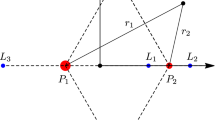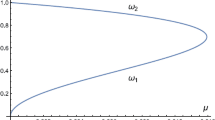Abstract
We study a particular \((1+2n)\)-body problem, conformed by a massive body and 2n equal small masses, since this problem is related with Maxwell’s ring solutions, we call planet to the massive body, and satellites to the other 2n masses. Our goal is to obtain doubly-symmetric orbits in this problem. By means of studying the reversing symmetries of the equations of motion, we reduce the set of possible initial conditions that leads to such orbits, and compute the 1-parameter families of time-reversible invariant tori. The initial conditions of the orbits were determined as solutions of a boundary value problem with one free parameter, in this way we find analytically and explicitly a new involution, until we know this is a new and innovative result. The numerical solutions of the boundary value problem were obtained using pseudo arclength continuation. For the numerical analysis we have used the value of \(3.5 \times 10 ^{-4}\) as mass ratio of some satellite and the planet, and it was done for \(n=2,3,4,5,6\). We show numerically that the succession of families that we have obtained approach the Maxwell solutions as n increases, and we establish a simple proof why this should happen in the configuration.









Similar content being viewed by others
Notes
We have chosen this value in order to compare the results of this work with our previous studies.
References
Bengochea, A., Piña, E.: The Saturn, Janus and Epimetheus dynamics as a gravitational three body problem in the plane. Rev. Mexicana Fís. 55, 97–105 (2009)
Bengochea, A., Falconi, M., Pérez-Chavela, E.: Symmetric horseshoe periodic orbits in the general planar three-body problem. Astrophys. Space Sci. 333, 399–408 (2011). https://doi.org/10.1007/s10509-011-0641-x
Bengochea, A., Falconi, M., Pérez-Chavela, E.: Horseshoe periodic orbits with one symmetry in the general planar three-body problem. Discrete Contin. Dyn. Syst. Ser. A 33, 987–1008 (2013). https://doi.org/10.3934/dcds.2013.33.987
Bengochea, A., Galán, J., Pérez-Chavela, E.: Doubly-symmetric horseshoe orbits in the general planar three-body problem. Astrophys. Space Sci. 348, 403–415 (2013). https://doi.org/10.1007/s10509-013-1590-3
Bengochea, A., Galán, J., Pérez-Chavela, E.: Exchange orbits in the planar \((1+4)\)-body problem. Physica D 301–302, 21–35 (2015). https://doi.org/10.1016/j.physd.2015.03.006
Bruno, A.D., Varin, V.P.: Periodic solutions of the restricted three-body problem for a small mass ratio. J. Appl. Math. Mech. 71, 933–960 (2007). https://doi.org/10.1016/j.jappmathmech.2007.12.012
Cors, J.M., Hall, G.R.: Coorbital periodic orbits in the three body problem. SIAM J. Appl. Dyn. Syst. 2, 219–237 (2003). https://doi.org/10.1137/S1111111102411304
Cors, J.M., Llibre, J., Ollé, M.: Central configurations of the planar coorbital satellite problem. Celest. Mech. Dynam. Astron. 89, 319–342 (2004). https://doi.org/10.1023/B:CELE.0000043569.25307.ab
Cors, J.M., Palacián, J.F., Yanguas, P.: On co-orbital quasi-periodic motion in the three-body problem. SIAM J. Appl. Dyn. Syst. 18, 334–353 (2019). https://doi.org/10.1137/18M1190859
Doedel, E.J.: AUTO: a program for the automatic bifurcation analysis of autonomous systems. Congr, Numer. 30, 265–284 (1981)
Doedel, E.J., Paffenroth, R.C., Keller, H.B., Dichmann, D.J., Galán-Vioque, J., Vanderbauwhede, A.: Computation of Periodic Solutions of Conservative Systems With Application to the 3-Body Problem. Internat. J. Bifur. Chaos Appl. Sci. Engrg. 13, 1353–1381 (2003). https://doi.org/10.1142/S0218127403007291
Dermott, S.F., Murray, C.D.: The dynamics of tadpole and horseshoe orbits: I. Theory. Icarus 48, 1–11 (1981). https://doi.org/10.1016/0019-1035(81)90147-0
Dermott, S.F., Murray, C.D.: The dynamics of tadpole and horseshoe orbits: II. The coorbital satellites of saturn. Icarus 48, 12–22 (1981). https://doi.org/10.1016/0019-1035(81)90148-2
Funk, B., Dvorak, R., Schwarz, R.: Exchange orbits: an interesting case of co-orbital motion. Celest. Mech. Dynam. Astron. 117, 41–58 (2013). https://doi.org/10.1007/s10569-013-9497-4
Galán, J., Muñoz-Almaraz, F. J., Freire, E., Doedel, E., Vanderbauwhede, A.: Stability and Bifurcations of the Figure-8 Solution of the Three-Body Problem. Phys. Rev. Lett. 88, 241101-241101-4 (2002) https://doi.org/10.1103/PhysRevLett.88.241101
Lamb, J.S.W., Roberts, J.A.G.: Time-reversal symmetry in dynamical systems: A survey. Phys. D 112, 1–39 (1998). https://doi.org/10.1016/S0167-2789(97)00199-1
Laughlin, G., Chambers, J.E.: Extrasolar trojans: the viability and detectability of planets in the 1:1 resonance. Astrophys. J. 124, 592–600 (2002). https://doi.org/10.1086/341173
Llibre, J., Ollé, M.: The motion of Saturn coorbital satellites in the Restricted Three-Body Problem. Astron. Astrophys. 378, 1087–1099 (2001). https://doi.org/10.1051/0004-6361:20011274
Maxwell, C.J.: On the stability of the motion of Saturn’s Rings. In: Niven, W.D. (ed.) The Scientific Papers of James Clerk Maxwell, pp. 288–376. Dover Publications, New York (1965)
Muñoz-Almaraz, F.J., Freire, E., Galán, J., Doedel, E., Vanderbauwhede, A.: Continuation of periodic orbits in conservative and hamiltonian systems. Phys. D 181, 1–38 (2003). https://doi.org/10.1016/S0167-2789(03)00097-6
Muñoz-Almaraz, F.J., Freire, E., Galán, J., Vanderbauwhede, A.: Continuation of normal doubly symmetric orbits in conservative reversible systems. Celest. Mech. Dynam. Astron. 97, 17–47 (2007). https://doi.org/10.1007/s10569-006-9048-3
Niederman, L., Pousse, A., Robutel, P.: On the co-orbital motion in the three-body problem: existence of quasi-periodic horseshoe-shaped orbits. Commun. Math. Phys. 377, 551–612 (2020). https://doi.org/10.1007/s00220-020-03690-8
Renner, S., Sicardy, B.: Stationary configurations for co-orbital satellites with small arbitrary masses. Celest. Mech. Dynam. Astron. 88, 397–414 (2004). https://doi.org/10.1023/B:CELE.0000023420.80881.67
Vanderbauwhede, A.: Continuation and bifurcation of multi-symmetric solutions in reversible Hamiltonian systems. Discrete Contin. Dyn. Syst. Ser. A 33, 359–363 (2013). https://doi.org/10.3934/dcds.2013.33.359
Verrier, P.E., McInnes, C.: Periodic orbits for three and four co-orbital bodies. Mon. Not. R. Astron. Soc. 442, 3179–3191 (2014). https://doi.org/10.1093/mnras/stu1056
Salo, H., Yoder, C. F.: Dynamics of coorbital satellite rings. In: Valtonen, M. J. (ed.) The few body problem, Astrophys. Space Sci. Libr., vol. 140, pp. 179-184, Kluwer Academic Publishers, Dordrecht (1988)
Acknowledgements
We thank to the anonymous referee for pointing out some references that we had missed, which help us in the drafting of the new manuscript. The first and third author have been partially supported from Asociación Mexicana de Cultura A.C., the National System of Researchers (SNI), and Conacyt-México Project A1S10112. The second author wishes to acknowledge financial support from the Spanish government through grants PGC2018-096265-B-I00 and PGC2018-100680-B-C21. We would like to thank Rafael Ortega for valuable comments and suggestions.
Author information
Authors and Affiliations
Corresponding author
Additional information
Publisher's Note
Springer Nature remains neutral with regard to jurisdictional claims in published maps and institutional affiliations.
Rights and permissions
About this article
Cite this article
Bengochea, A., Galán-Vioque, J. & Pérez-Chavela, E. Families of Symmetric Exchange Orbits in the Planar \((1+2n)\)-Body Problem. Qual. Theory Dyn. Syst. 20, 34 (2021). https://doi.org/10.1007/s12346-021-00473-x
Received:
Accepted:
Published:
DOI: https://doi.org/10.1007/s12346-021-00473-x




